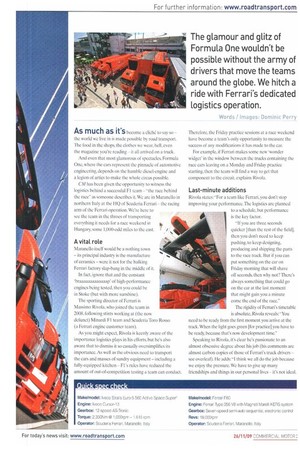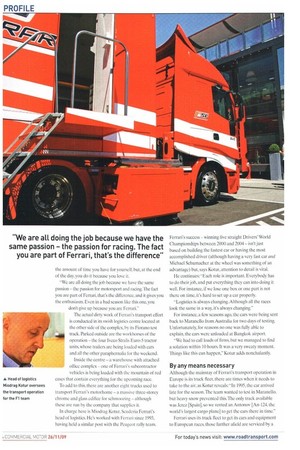As much as it's become a clich(3 to say so
Page 33

Page 34

Page 35

If you've noticed an error in this article please click here to report it so we can fix it.
the world we live in is made possible by road transport. The food in the. shops, the clothes we wear, hell, even the magazine you're reading it all arrived on a truck. And even that most glamorous of spectacles, Formula One, where the cars represent the pinnacle of automotive engineering, depends on the humble diesel-engine and a legion of artics to make the whole circus possible. CM has been given the opportunity to witness the logistics behind a successful Fl team -"the race behind the race" as someone describes it. We are in Maranello in northern Italy at the HQ of Scuderia Ferrari the racing arm of the Ferrari operation. We're here to see the team in the throes of transporting everything it needs for a race weekend in Hungary, some 1,000-odd miles to the east
A vital role
Maranello itself would he a nothing town its principal industry is the manufacture of ceramics were it not for the hulking Ferrari factory slap-bang in the middle of it. In fact, ignore that and the constant 'braaaaaaaaaaaaap' of high-performance engines being tested, then you could be in Stoke (but with more sunshine). The sporting director of Ferrari is Massimo Rivola, who joined the team in 2008, following stints working at (the now defunct) Minardi Fl team and Scuderia Toro Rosso (a Ferrari engine customer team).
As you might expect, Rivola is keenly aware of the importance logistics plays in his efforts, but he's also aware that to dismiss it so casually oversimplifies its importance. As well as the obvious need to transport the cars and masses of sundry equipment including a fully-equipped kitchen Fl 's rules have reduced the amount of out-of-competition testing a team can conduct. Therefore, the Friday practice sessions at a race weekend have become a team's only opportunity to measure the success of any modifications it has made to the car.
For example, if Ferrari makes some new 'wonder widget' in the window between the trucks containing the race cars leaving on a Monday and Friday practice starting, then the team will find a way to get that component to the circuit, explains Rivola.
Last-minute additions
Rivola states: For a Learn like Ferrari, you don't stop improving your performance. The logistics are planned to a schedule, but performance is the key factor.
"If you are three seconds quicker [than the rest of the field], then you don't need to keep pushing, to keep designing, producing and shipping the parts to the race track. But if you can put something on the car on Friday morning that will shave off seconds, then why not? There's always something that could go on the car at the last moment that might gain you a minute come the end of the race."
The rigidity of Ferrari's timetable is absolute, Rivola reveals: -You need to be ready from the first moment you arrive at the track.When the light goes green for practice] you have to he ready, because that's now development time."
Speaking to Rivola, it's clear he's passionate to an almost obsessive degree about his job (his comments are almost carbon copies of those of Ferrari's truck drivers see overleaf). He adds: -11 think we all do the job because we enjoy the pressure. We have to give up many friendships and things in our personal lives it's not ideal,
the amount of time you have for yourself, but, at the end of the day you do it because you love it.
-We are all doing the job because we have the same passion the passion for motorsport and racing. The fact you are part of Ferrari, that's the difference, and it gives you the enthusiasm. Even in a bad season like this one, you don't give up because you are Ferrari."
The actual dirty work of Ferrari's transport effort is conducted in its swish logistics centre located at the other side of the complex, by its Fiorano test track. Parked outside are the workhorses of the operation the four Iveco Stralis Euro-5 tractor units, whose trailers are being loaded with cars and all the other paraphernalia for the weekend.
Inside the centre a warehouse with attached office complex one of Ferrari's subcontractor vehicles is being loaded with the mountain of red cases that contain everything for the upcoming race.
To add to this, there are another eight trucks used to transport Ferrari's motorhome a massive three-storey chrome and glass edifice for schmoozing although these are run by the company that supplies it.
In charge here is Miodrag Kotur, Scucleria Ferrari's head of logistics. He's worked with Ferrari since 1993, having held a similar post with the Peugeot rally team. Ferrari's success winning live straight Drivers' World Championships between 2000 and 2004isn't just based on building the fastest car or having the most accomplished driver (although having a very fast car and Michael Schumacher at the wheel was something of an advantage) but, says Kotur, attention to detail is vital.
He continues: "Each role is important. Everybody has to do their job, and put everything they can into doing it well. For instance, if we lose one box or one part is not there on time, it's hard to set up a car properly.
"Logistics is always changing. Although all the races look the same in a way, it's always changing."
For instance, a few seasons ago, the cars were being sent back to Maranello from Australia for two days of testing. Unfortunately, for reasons no one was fully able to explain, the cars were unloaded at Bangkok airport.
"We had to call loads of firms, but we managed to find a solution within 10 hours. It was a very sweaty moment. Things like this can happen," Kotur adds nonchalantly.
By any means necessary
Although the mainstay of Ferrari's transport operation in Europe is its truck fleet, there are times when it needs to take to the air, as Kotur reveals: "In 1995, the car arrived late for the season. The team wanted to test in Maranello, but heavy snow prevented this, The only track available was Jerez [Spain], so we rented an Antonov [An-124, the world's largest cargo plane] to get the cars there in time."
Ferrari uses its truck fleet to get its cars and equipment to European races, those further afield are serviced by a mixture of sea and air freight. In fact, for the less-valuable items, Ferrari has copies of each and ships them well in advance in containers. Kotur says:"It's cheaper to have four of some things than send everything by air freight."
In all, some IS tonnes of material garage panels, tools and so on is sent via container ship.
A winning can-do attitude
Although the Fl management organises the transport for the teams for the distant races, there are always last-minute components the teams need to ship themselves via air freight. Mind you, even here. Ferrari has its own way of doing things.
"If there's a problem with weight [on a flight', the first thing to come off is cargo, so we buy two passenger seats: one for the courier and one for the part," reveals Kotur.
The most difficult GPs this season -from a logistics point of view, at least were the European GP in Valencia. Spain, shortly followed by Spa in Belgium a week later and 1,600km distant. Drivers were swapped at a convenient halfway point. Kotur likens it to a Wild West-era stagecoach that would switch horses in order to maintain its pace. They are also the most expensive races due to the number of people involved in the operation.
China is also complicated, he says, because of the bureaucracy: Monaco too is a "nightmare" because of the access issues, he reveals, but it does have its plus points...
"From a logistics point of view," he says, "Monaco is difficult, but other than that, everybody likes it. It's on a beach and it's usually sunny."
Meanwhile, the trucks are preparing to leave.They are double-manned, but don't drive through the night because the drivers work at the race, so they can't be too tired when they reach their destination.They won't get to the track until Wednesday, with the Thursday used to set up and the weekend beginning on Friday with free practice, Saturday qualifying and the race on Sunday As we said earlier, out-of-race testing is banned, so Friday practice is vital because it's the only time a team can test modifications or new components. If the team thinks a few thousandths of a second can be shaved off a lap time, it won't hesitate to send the parts via express courier DHL out to the track as late in the day as possible.
It's this attitude that breeds results Kimi RaikkOnen grabs second in Hungary (albeit overshadowed by fellow Ferrari driver Felipe Massa's horrific head injury).
It's worth remembering, then, that for all Ferrari's engineering excellence, without its fleet of Ivecos and the dedication of their drivers, they wouldn't be racing. •








































































































































